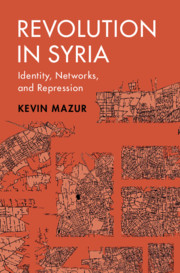Book contents
- Revolution in Syria
- Cambridge Studies in Comparative Politics
- Revolution in Syria
- Copyright page
- Dedication
- Contents
- Figures
- Tables
- Acknowledgments
- A Note on Transliteration
- 1 Introduction
- 2 Theory
- 3 Networks, Identities, and Patronage in Contemporary Syria
- 4 Events of the Syrian Uprising
- 5 Initial Forms of Challenge
- 6 State Networks and Nonparticipation
- 7 Logics of State Repression and Societal Response
- 8 Particularizing Challenge in Kurdish Areas
- 9 Conclusion
- Appendix
- Chronology of Major Events in the First Year of the 2011 Syrian Uprising
- References
- Index
- Series page
3 - Networks, Identities, and Patronage in Contemporary Syria
Published online by Cambridge University Press: 18 June 2021
- Revolution in Syria
- Cambridge Studies in Comparative Politics
- Revolution in Syria
- Copyright page
- Dedication
- Contents
- Figures
- Tables
- Acknowledgments
- A Note on Transliteration
- 1 Introduction
- 2 Theory
- 3 Networks, Identities, and Patronage in Contemporary Syria
- 4 Events of the Syrian Uprising
- 5 Initial Forms of Challenge
- 6 State Networks and Nonparticipation
- 7 Logics of State Repression and Societal Response
- 8 Particularizing Challenge in Kurdish Areas
- 9 Conclusion
- Appendix
- Chronology of Major Events in the First Year of the 2011 Syrian Uprising
- References
- Index
- Series page
Summary
This chapter sets the political and social context for the events of the 2011 Syrian uprising. It describes the topography of ethnic boundaries and, using original quantitative data, shows that ʿAlawis were disproportionate beneficiaries of state largesse, accessed through informal ties and formal positions in the civil service and military. Nonetheless, substantial segments of the Sunni Arab population were also tied to the state through personalistic ties and public institutions. Then it describes the relationship between ethnicity and state access in historical and theoretical terms, arguing that the Baʿth regime instrumentalized existing social structures in some cases, building ties to local leaders with customary status, and worked to break down these ties in other cases, building new ties with individual citizens through corporatist development and state employment. Finally, the chapter examines the effects of neoliberal policies, enacted after 2000, on these linkages. It argues that these policies exacerbated the suffering of many Syrians already lacking state access but left the cross-ethnic structure of state–society ties intact.
Keywords
- Type
- Chapter
- Information
- Revolution in SyriaIdentity, Networks, and Repression, pp. 60 - 93Publisher: Cambridge University PressPrint publication year: 2021



